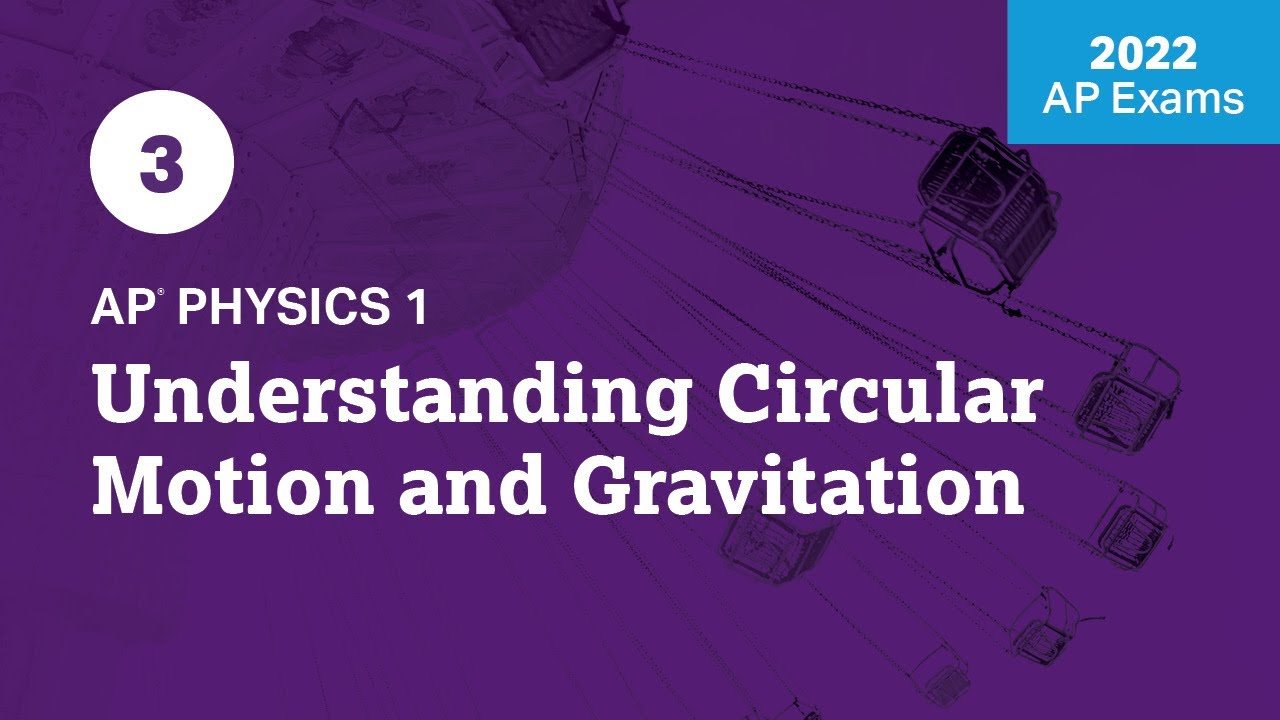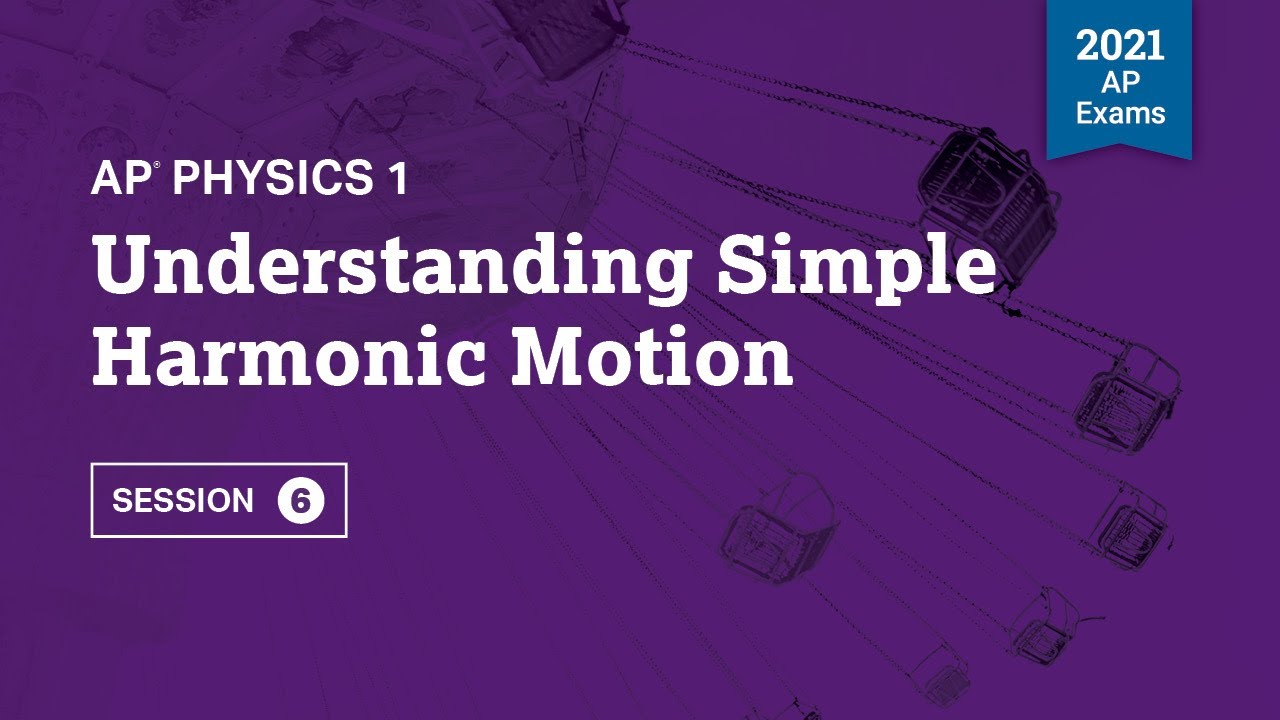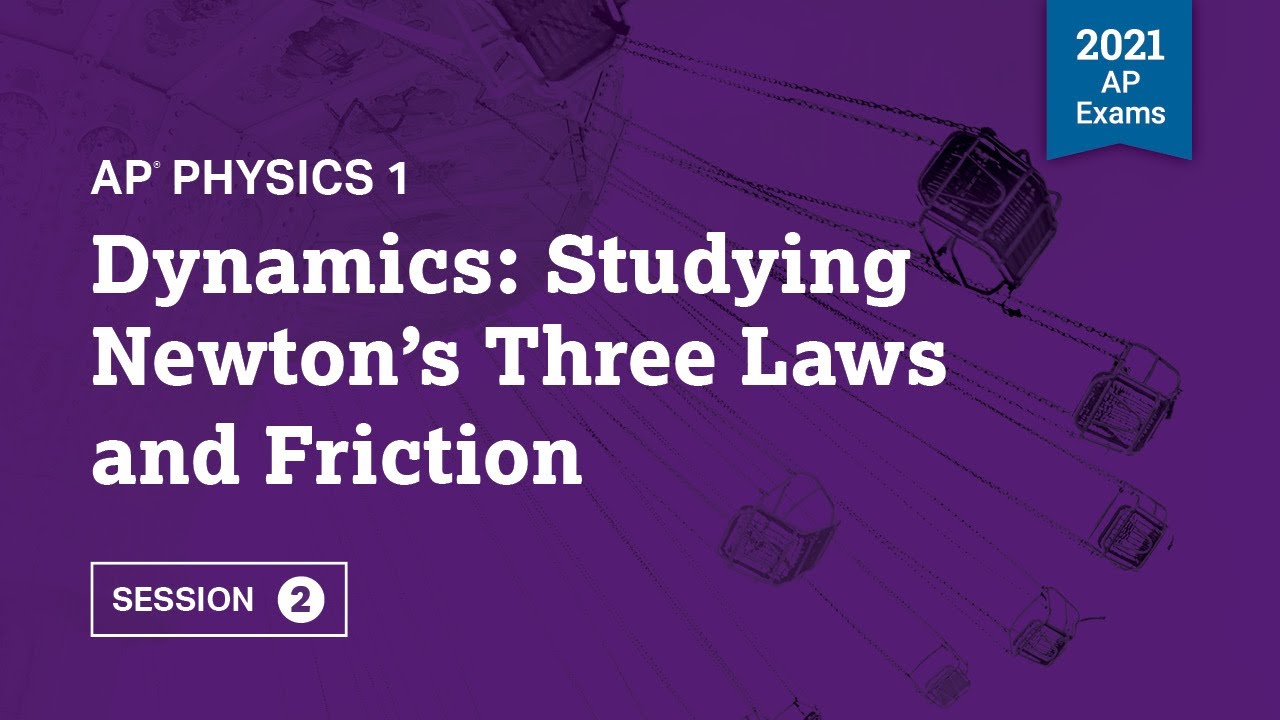2021 Live Review 3 | AP Physics 1 | Understanding Circular Motion and Gravitation
TLDRIn this engaging AP Physics 1 review session, Joshua Beck delves into the concepts of gravitation and uniform circular motion, offering valuable tips and tricks for exam preparation. He introduces a factor of change technique, demonstrating how it can simplify numerical problems without the need for extensive calculations. Through real-world examples and interactive segments, Beck helps students understand the direct proportionality of gravitational force to mass and the inverse square law of distance. He also clarifies misconceptions about centripetal force and acceleration, emphasizing that centripetal force is not an additional force but a result of existing forces. The session is informative, interactive, and tailored to enhance students' comprehension and problem-solving skills in physics.
Takeaways
- 🌌 Understanding gravitation is crucial, as it's the force of attraction between any two masses and is directly proportional to both masses and inversely proportional to the square of the distance between them.
- 🔢 A sneaky way to solve numerical problems related to gravitation involves focusing on how variables change rather than performing full calculations, which can save time and effort.
- 📈 When analyzing problems where variables change, isolating the changing variable and understanding its proportionality to the outcome can lead to quick solutions without extensive calculations.
- 🪐 The gravitational force between two objects can be easily calculated and compared using the factor of change technique, even without knowing the exact values of masses and distances.
- 🔄 In uniform circular motion, an object experiences a centripetal force that is directed towards the center of the circular path, and this force is necessary to keep the object moving in a circle at constant speed.
- 🚀 Centripetal acceleration is given by the formula a = v^2 / r, where v is the velocity of the object and r is the radius of the circular path.
- 📊 The factor of change technique can also be applied to centripetal force and acceleration problems, allowing for quick determinations of changes in force or speed.
- 🔧 Centripetal force is not an additional or separate force; it is the result of one of the existing forces, such as tension or friction, acting in a way that causes the centripetal acceleration.
- 🔄 When the speed of an object in circular motion increases, the required centripetal force also increases, which can lead to a change in the radius of the path if the providing force (like friction) reaches its maximum limit.
- 🌍 The gravitational field strength at a point above the Earth's surface can be calculated using the gravitational field formula, and it changes in relation to the Earth's mass and the distance from the center of the Earth.
- 🌕 The gravitational field strength on the Moon might be different from that on Earth due to differences in mass and radius, and understanding these differences can help explain students' misconceptions about gravitational fields.
Q & A
What is the force of gravitation and how does it relate to the masses and distance between two objects?
-The force of gravitation is the attractive force between any two masses, regardless of their size or the distance between them. It is directly proportional to the product of the masses and inversely proportional to the square of the distance between their centers. This relationship is described by the equation F = G * (m1 * m2) / r^2, where F is the gravitational force, G is the gravitational constant, m1 and m2 are the masses, and r is the distance between the centers of the two masses.
How can one solve numerical problems involving gravitation without using a calculator?
-By understanding the relationship between the variables in the gravitational force equation, one can determine the effect of changing one variable on the overall force without performing full calculations. For example, if one mass is tripled, the force will also triple since the force is directly proportional to the mass. This method relies on the principle of proportionality and can be applied to various equations in physics.
What is the significance of the 'factor of change' technique in solving physics problems?
-The 'factor of change' technique is a useful method for quickly estimating the outcome of a physical situation without extensive calculations. By identifying the variables that change and their respective factors, one can determine the overall effect on the result. This technique is particularly helpful for multiple-choice questions or when solving problems with large numbers, as it simplifies the process and provides a quick estimate of the outcome.
How does the distance between two objects affect the gravitational force between them?
-The gravitational force is inversely proportional to the square of the distance between the objects. If the distance is doubled, the gravitational force is reduced to a quarter of its original value (since the distance term in the denominator is squared). Conversely, if the distance is halved, the gravitational force is quadrupled.
What is uniform circular motion and why is it considered an accelerated motion?
-Uniform circular motion is when an object moves in a circular path at a constant speed. Although the speed (magnitude of velocity) is constant, the direction of the velocity vector is continually changing. Since acceleration is defined as the rate of change of velocity, and velocity is a vector quantity with both magnitude and direction, a changing direction implies there is acceleration. This acceleration is always directed towards the center of the circular path, which is known as centripetal acceleration.
What is the relationship between centripetal force and the velocity of an object in uniform circular motion?
-The centripetal force is the force required to keep an object in uniform circular motion. It is directly proportional to the mass of the object, the square of its velocity, and inversely proportional to the radius of the circular path (Fc = m * v^2 / r). As the velocity of the object increases, the required centripetal force also increases, since the force is directly proportional to the square of the velocity.
What is the role of tension in creating centripetal force in a circular motion scenario?
-In a scenario where an object is tied with a string and made to move in a circular path, the tension in the string provides the necessary centripetal force. The tension is not an additional force but rather the result of the string's pulling force that is directed towards the center of the circular path, creating the centripetal acceleration needed for circular motion.
How does the gravitational field strength (g) at a point above the Earth's surface change with altitude?
-The gravitational field strength at a point above the Earth's surface decreases with increasing altitude. At one Earth radius above the surface, the gravitational field strength is approximately halved (around 4.9 N/kg). If the altitude is increased to two Earth radii, the gravitational field strength is roughly one-third (around 3.3 N/kg), and at three Earth radii, it is about one-fifth (around 1.96 N/kg) of the value at the surface.
How does the gravitational field strength on the Moon compare to that on Earth?
-The gravitational field strength on the Moon is less than that on Earth. This is because the Moon's mass is about 81 times smaller than Earth's, and its radius is about 3.7 times smaller. Even though a smaller radius would lead to a higher gravitational field strength if the mass were the same, the significantly smaller mass results in a lower overall gravitational field strength on the Moon.
What happens to the required centripetal force if the speed of an object in uniform circular motion is increased?
-If the speed of an object in uniform circular motion is increased, the required centripetal force also increases. This is because the centripetal force is directly proportional to the square of the velocity. For instance, doubling the speed would require four times the centripetal force, and tripling the speed would require nine times the centripetal force.
What is the role of friction in maintaining circular motion on a horizontal surface?
-Friction plays a crucial role in maintaining circular motion on a horizontal surface, especially when there is no string or tether involved. The frictional force acts as the centripetal force, keeping the object in its circular path. As the speed of the object increases, the required frictional force also increases to provide the necessary centripetal force. However, once the speed reaches a point where the frictional force cannot increase any further, the object will move to a larger radius to maintain its motion, as the available frictional force is not sufficient to provide the required centripetal force at the higher speed.
Outlines
📘 Introduction to AP Physics 1 Review
This paragraph introduces the video as a review session for AP Physics 1, led by Joshua Beck. The speaker aims to provide course-specific tips and tricks to help prepare for the AP Physics 1 exam. He mentions that while he is leading the session today, Kristen will take over the following days. The focus for this session is on gravitation and uniform circular motion, with an emphasis on solving numerical problems efficiently without the need for a calculator or complete information.
🔧 Gravitational Force and Problem-Solving Techniques
In this paragraph, the speaker delves into the concept of gravitational force, explaining its proportionality to the masses involved and its inverse proportionality to the square of the distance between them. The speaker then introduces a sneaky trick for solving problems related to gravitational force without the need for extensive calculations or even knowing all the values. This trick involves understanding how changes in the variables affect the outcome and using this relationship to determine the factor by which the answer changes. Several examples are provided to illustrate how this technique can simplify problem-solving in various scenarios.
🔄 Factor of Change Technique and its Limitations
This paragraph continues the discussion on the factor of change technique, emphasizing its usefulness in quickly solving multiple-choice questions. The speaker explains how the technique can be applied to different variables and situations, but also points out its limitations. It does not work when multiple terms are added or subtracted from each other, and it may not provide the exact value but can indicate the direction and magnitude of change. The speaker uses examples from the College Board's AP Physics 1 workbook to demonstrate how the technique can be applied to compare gravitational forces between objects without complex calculations.
📈 Ranking Task and Gravitational Force Analysis
The speaker introduces a ranking task, a common problem type in AP Physics exams, where students are required to order scenarios based on the strength of gravitational force. The speaker emphasizes the importance of understanding the ranking order and presenting the answer correctly. Using the provided diagrams and the knowledge that all spheres have the same mass, the speaker guides through the process of ranking the scenarios by comparing the denominators in the gravitational force equation. The speaker also addresses a common misconception about the factor of change technique and its application in different contexts.
🌍 Gravitational Field Strength and Planetary Comparisons
This paragraph focuses on the concept of gravitational field strength, explaining how it can be calculated using the gravitational force equation and how it relates to the mass of the celestial body and the distance from its center. The speaker uses the example of the Earth and a hypothetical planet to demonstrate how changes in mass and radius affect the gravitational field strength. The speaker also compares the Earth to the Moon, using the factor of change technique to analyze the gravitational field strength on the Moon's surface, taking into account the differences in mass and radius between the Earth and the Moon.
🔄 Centripetal Force and Uniform Circular Motion
The speaker transitions from gravitational force to uniform circular motion, clarifying common misconceptions about centripetal force. The speaker explains that centripetal force is not a separate type of force but rather the result of existing forces creating a centripetal acceleration. The speaker uses Newton's second law to derive the formula for centripetal force and provides a practical demonstration involving a low friction cart on a horizontal track. The demonstration illustrates how the tension in the string provides the necessary centripetal force to keep the cart moving in a circular path.
🏎️ Dynamics of Circular Motion and Frictional Force
In this paragraph, the speaker explores a different scenario involving a disc in uniform circular motion on a horizontal surface. The speaker identifies the forces acting on the disc and explains that the centripetal force in this case is provided by a frictional force. The speaker discusses how increasing the speed of the disc requires a greater frictional force to maintain the circular motion. The speaker also describes a situation where the required frictional force exceeds the maximum available friction, leading to a change in the radius of the circular path as the speed continues to increase.
🌐 Circular Orbits and Additional Resources
The speaker concludes the session by briefly mentioning that gravitational forces and uniform circular motion come together in the concept of circular orbits, a topic not covered in detail during the session. The speaker provides additional resources, including videos from AP Classroom, for further review and emphasizes the importance of selecting the most relevant resources based on individual needs. The speaker also informs the audience about the schedule for upcoming review sessions, with Kristen taking over the next few days.
Mindmap
Keywords
💡Gravitational Force
💡Uniform Circular Motion
💡Centripetal Force
💡Factor of Change Technique
💡Newton's Second Law
💡Frictional Force
💡Tension
💡Gravitational Field
💡Circular Orbits
💡Physics Review
Highlights
The review session focuses on gravitation and uniform circular motion, providing tips and tricks for the AP Physics 1 exam.
Gravitational force is directly proportional to the product of the masses and inversely proportional to the square of the distance between them.
A sneaky method to solve numerical problems without a calculator or knowing all the values is introduced.
If one mass is tripled, the gravitational force also triples due to direct proportionality.
Doubling the distance between two objects reduces the gravitational force by a factor of four, as the force is inversely proportional to the square of the distance.
The factor of change technique can be applied to various equations to quickly determine the effect of changing variables.
The gravitational force between two objects can be calculated without plugging in the full values of mass and distance.
Ranking tasks require ordering scenarios from strongest to weakest or vice versa, which can be done by comparing the denominators in the gravitational force equation.
If masses are doubled while the radius remains the same, the gravitational force increases by a factor of four.
The gravitational field strength on the moon might be argued to be greater than Earth's based on the inverse square relationship with radius, but it is actually less due to the moon's smaller mass.
Centripetal force is not a separate type of force but the result of existing forces that cause an object to move in a circular path.
In uniform circular motion, the direction of velocity is constantly changing, which means there is acceleration even if the speed is constant.
The force required for centripetal acceleration is provided by tension or friction and can be calculated using the formula F = m*v^2/r.
If the speed in uniform circular motion increases, the required centripetal force also increases proportionally.
In a demonstration, increasing the speed of a cart on a horizontal track results in a proportional increase in the tension required to maintain circular motion.
When a disc is spun on a horizontal surface, friction provides the centripetal force needed to keep it in circular motion.
As speed increases, the required centripetal force surpasses the maximum frictional force, causing the radius of the motion to increase to maintain the motion.
Additional resources on AP Classroom are recommended for further review and understanding of the topics discussed.
Transcripts
Browse More Related Video

2022 Live Review 3 | AP Physics 1 | Understanding Circular Motion and Gravitation

2021 Live Review 6 | AP Physics 1 | Understanding Simple Harmonic Motion

Centripetal force problem solving | Centripetal force and gravitation | Physics | Khan Academy

What Is Circular Motion? | Physics in Motion

2021 Live Review 2 | AP Physics 1 | Dynamics: Studying Newton’s Three Laws and Friction

unit 3 review - Circular motion and gravitation
5.0 / 5 (0 votes)
Thanks for rating: